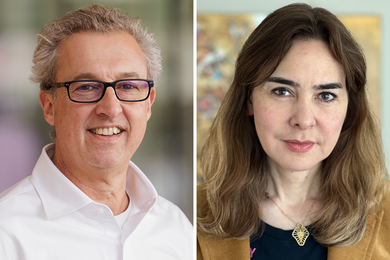If you live in the developed world, safe water is usually just a faucet-turn away. And yet, global warming, drought conditions, and population growth in coming decades could change that, ushering in an era of uncertain access to water.
Now an MIT-based research team has evaluated those potential problems and, based on a case study in Australia, suggested an alternate approach to water planning. In a new paper, the researchers find there is often a strong case for building relatively modest, incremental additions to water infrastructure in advanced countries, rather than expensive larger-scale projects that may be needed only rarely.
More specifically, the study looks at the city of Melbourne, where a 12-year drought from 1997 to 2009 led to construction of a $5 billion facility, the Victorian Desalination Plant. It was approved in 2007 and opened in 2012 — at a time when the drought had already receded. As a result, the plant has barely been used, and its inactivity, combined with its hefty price tag, has generated considerable controversy.
As an alternative, the study suggests, smaller, modular desalination plants could have met Melbourne’s needs at a lower price.
“If you build too much infrastructure, you’re building hundreds of millions or billions of dollars in assets you might not need,” says Sarah Fletcher, a PhD candidate in MIT’s Institute for Data, Systems, and Society (IDSS), who is the lead author of the new paper.
To be sure, Fletcher adds, “You don’t want to be in a situation where you have less water supply than you have demand.” As such, the study does not argue that a single solution applies to all cases, but presents a new method for pinpointing the best plan — and notes that in many cases, “moderate investment increases, together with flexible infrastructure design, can mitigate water-shortage risk significantly.”
The new paper, “Water Supply Infrastructure Planning: Decision-Making Framework to Classify Multiple Uncertainties and Evaluate Flexible Design,” was recently published online in the Journal of Water Resources Planning and Management, and will appear in the October 2017 print volume.
The co-authors are Fletcher, who is also affiliated with MIT’s Joint Program on the Science and Policy of Global Change; Marco Miotti, a PhD student in IDSS; Jaichander Swaminathan, a PhD student in MIT’s Department of Mechanical Engineering; Magdalena Klemun, a PhD student in IDSS; Kenneth Strzepek, a research scientist at the MIT Joint Program on the Science and Policy of Global Change and an emeritus professor of engineering at the University of Colorado; and Afreen Siddiqi, a research scientist in IDSS.
Siddiqi visited Melbourne during its historic drought and learned from local experts about the city’s challenging water-supply problem. The genesis of the current study comes from Siddiqi’s investigation into the Melbourne case and assessment that the complex problem of urban water security lies at the intersection of engineering design and strategic planning.
The MIT team’s new framework for water-supply analysis incorporates several uncertainties that policymakers must confront in these cases, and runs large numbers of simulations of water availability over a 30-year period. It then presents planners with a decision tree about which infrastructure options are best calibrated to their needs.
The significant uncertainties include climate change and its effects on rainfall, as well as the impact of water shortages and population growth.
In studying the Melbourne case, the researchers looked at six infrastructure alternatives, including multiple types of desalination plants and a possible new pipeline to more-distant sources, and combinations of these things.
“The main methodological contribution for the paper is this framework to look at different uncertainties of different types and put that all together in one piece of analysis,” Fletcher says.
The results highlight a vexing problem in water-access planning: Shortages can be acute, but they may last for relatively short periods of time.
For instance, the team ran 100,000 simulations of 30-year conditions in Melbourne and found that in 80 percent of all years, there would be no water shortages at all. And yet, for the years where drought conditions did hold, large water shortages were more common than minor water shortages.
As a result, when costs were factored into the analysis, simply building no new infrastructure was the best option around 50 percent of the time. However, doing nothing was also the “worst-performing alternative” around 30 percent of the time.
That’s why the option of building smaller desalination plants can make sense. The Melboune plant that was built can produce 150 million cubic meters of water per year. But in the MIT team’s simulations, building a desalination plant half that size usually works well: It was the best-performing option in 20 percent of the simulations, and in the top three of 90 percent of the simulations. It was never, in all 100,000 simulations, the worst or second-worst-performing option.
Moreover, Fletcher points out, building smaller at first gives planners the ability to bring a new plant online more quickly and then scale up if needed.
“You only build a certain number of modules in the beginning, and you can add a certain number later,” Fletcher says. “That’s different than building a small plant and then another small plant. You’re being proactive and planning to adapt in the future.”
So thinking small, in this scenario, make considerable sense. But as the researchers acknowledge, the exact results of their study would likely vary from region to region, depending on all the climate and population factors that affect water supply.
Even so, they think their new study framework can at least help planners make the case that building on a smaller scale may position cities and countries best in the long run. Or, as Siddiqi puts it, “building on a smaller scale, but planning big” may be the optimal approach.
“We’re used to building large-scale desalination plants, and there’s less of history of building more modular plants,” Fletcher says. “It’s challenging because these are large investments with long lifetimes. But if you think of a modular plant as an insurance policy against drought, maybe you want to have it around.”


![“For China, it looks like industrial growth [has the greatest impact on water shortages] as people get wealthier,” Charles Fant says. “In India, population growth has a huge effect. It varies by region.”](/sites/default/files/styles/news_article__archive/public/images/201603/MIT-WaterChina.jpg?itok=in3EX01z)







